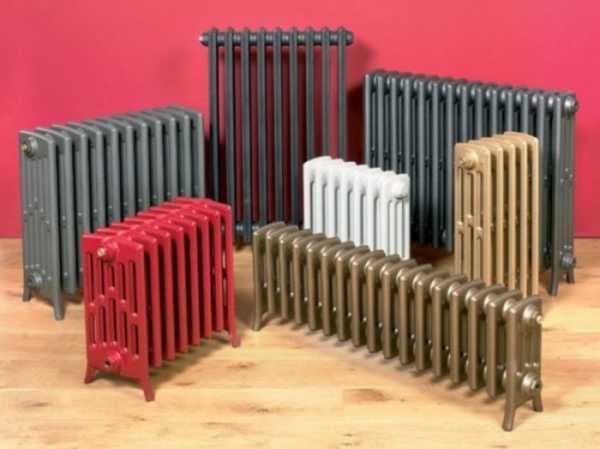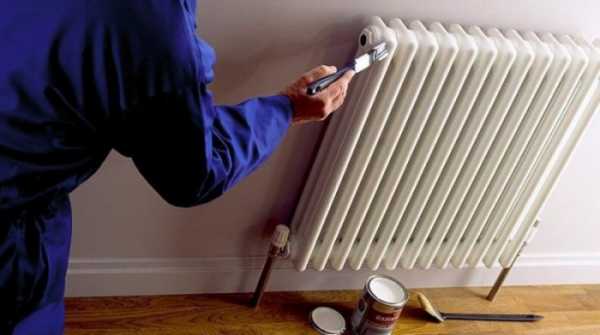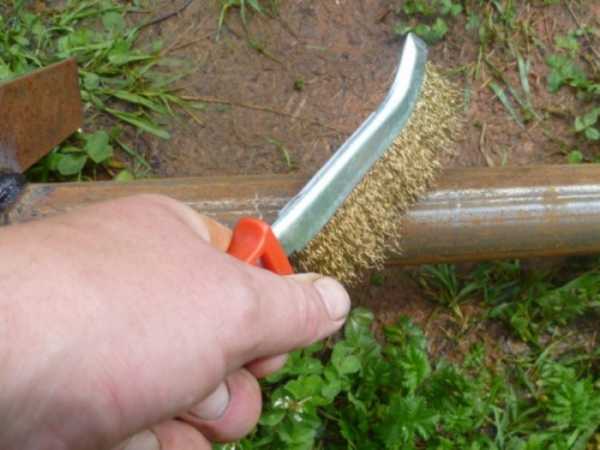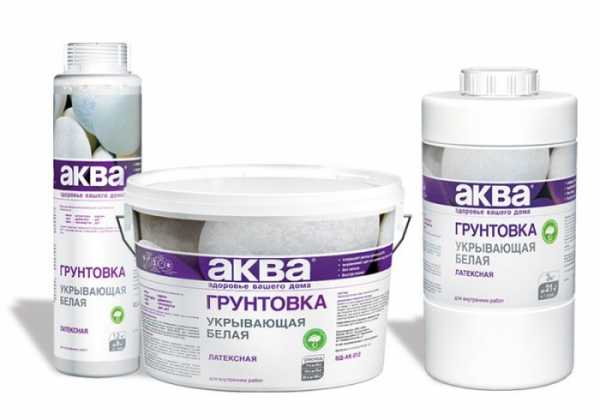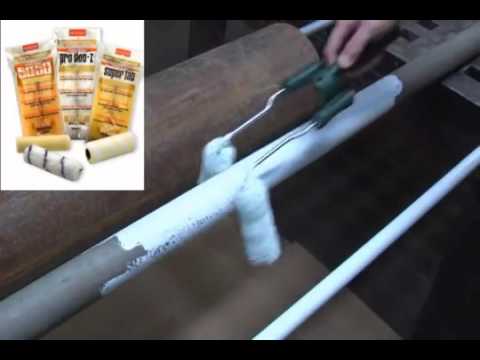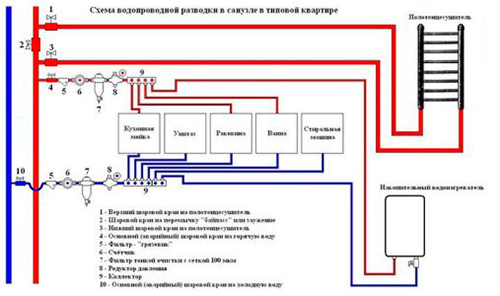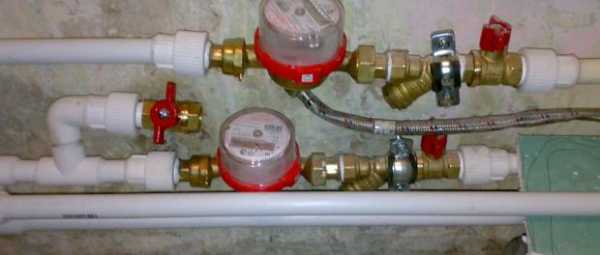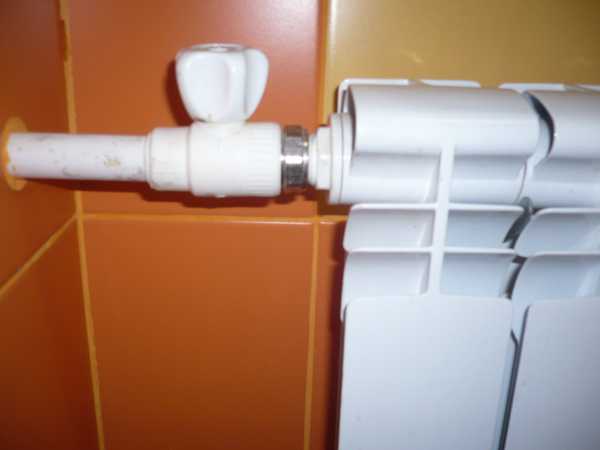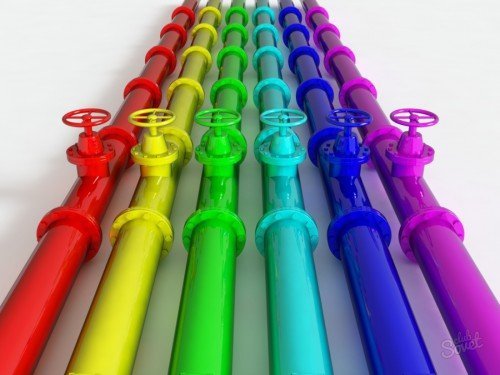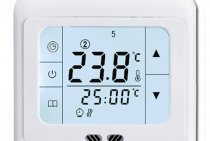Is it possible to paint hot heating pipes in an apartment
If you use a special dye correctly, you can give pipes and batteries a pleasant, updated look even in the heating season. But when choosing such a paint, you must have certain knowledge. After all, the work will be carried out in a residential area, therefore, special requirements are imposed on the dye:
- no harmful fumes;
- short drying period;
- long service life;
- protection of metal from rust;
- ease of use.
But even when choosing a paint with optimal characteristics for painting batteries, a simple layman can make a lot of mistakes when painting, since you still need to properly prepare the surface, select a tool and do the work properly. Further on this in more detail.
Staining options
- over the old layer, only if it is even and not damaged (no cracks, chips, bulges, etc.); preliminary sanding of the surface or complete removal of the old paint: if the previous layer is damaged (cracks or swelling are visible) or you notice rust (remove it with a metal brush); if the old paint leaves, it must be completely removed and then painted.
Don't forget primer if needed. The primer mixture is applied to a clean and dry surface, so carefully wipe the pipes with a damp cloth and wipe them dry with a rag.
Wait until the primer coat dries, and only then start painting.

As a rule, the paint is applied very simply and does not dry for long.
Try to keep the layer to a minimum. If the paint is translucent, it is better to open it twice with a thin layer than once with a thick one. Although usually even manufacturers recommend making the coating no less than two layers.
After the primer has dried, apply the paint with a roller or spray gun, and you can reach hard-to-reach places with a brush (if you can’t do it with an even brush, use a special radiator brush - it will easily pass into a thin opening and paint the part of the pipe hidden from the eyes).
Technology for painting polymer pipes
It is possible to paint hot pipes made of polymeric materials only after preliminary preparation. This is due to the fact that the glossy surface of the pipe prevents high-quality adhesion of the paint, and the coating will also leave much to be desired, which will entail the need to apply several layers of paint. To prevent this, the surface of the pipe is cleaned with sandpaper.
In the next step, the pipes are wiped with a damp cloth after sanding to remove dust. Make sure pipes are dry and clean before painting. After that, it is necessary to cover the floor and walls with a protective material (film) to prevent paint from entering.
If high-quality paint is used, which was mentioned earlier, then pipes can be painted without prior priming. Otherwise, it makes sense to cover the surface with a primer and only after it has dried, apply paint. The level of heat of the pipes when using high-quality paint does not matter, because its range of use allows you to paint at any temperature of the radiator.
Pipes are painted with a brush 5 cm wide. You can also use a roller in places where this is possible. The paint is applied in a thin layer so that there are no smudges. If the surface is not completely covered, it is necessary to paint a second time.
Pipe painting tips from professionals to self-taught
How to choose coating paints
The coating is selected depending on how the product will be used. If the pipes are intended for hot water supply (for example, heating or bathroom), then be sure to choose a material that can protect against rust when exposed to hot water.When you see the label “hot water supply” on the packaging, you can safely take it from the store shelf. Anti-corrosion paints are: pentaphthalic, organosilicon and alkyd. You can also use water-dispersed, but only before that carefully primed the surface to be painted. Oil paints should not be used due to the fact that they quickly change their color.
- Alkyd paints. Pros: they give a good coating, perfectly tolerate high temperatures, resist mechanical stress and are wear-resistant. The palette of colors of this paint is diverse. Cons: smells unpleasant even after drying.
- Water-dispersed. Pros: dry quickly and do not have a pronounced smell. Cons: lose color over time and require updating.
- Acrylic. Pros: they give a glossy shine and come from organic components, they keep their original appearance for a long time. Cons: they dry out for a long time and have a persistent and pungent smell of acetone and other solvents.
For cold water, pipes are painted with materials that can withstand condensate. They must adhere well to the metal and be applied without gaps. Be sure to clean the pipes from the old coating, otherwise the new layer will peel off. Even if outwardly everything looks normal, it is quite possible that the old layers are susceptible to corrosion and have already begun to flake off.
There are many types of paints in stores. The most popular of them are PF-115, because they are inexpensive and durable. But you can also use polyurethane, epoxy materials, which are more resistant to various influences.
You can also try special enamel for rust, but it is much more expensive than regular paints, as it contains a rust inhibitor, a primer with adhesion and enamel itself.
How to paint pipes: step by step instructions. Step 1: Prepare surfaces for painting
The main thing at the first stage of work is the cleaning of the old coating, especially places with rust. To do this, use a tin brush with coarse bristles. It is also worth using any kind of solvents. As a safety precaution, wear gloves and a dust and fumes mask. In order for the old paint to be removed almost imperceptibly, the surface is heated with a hairdryer, and only then they begin to clean it. After that, grease, dirt and dust are cleaned from the coating with a special composition. All of the above is done to ensure that the metal is preserved as long as possible.
Step 2: prime the pipes for durability
The main guarantee of rust protection and uniform application of the top coat is the surface primer. Builders recommend the use of alkyd paints, as they do an excellent job of preserving steel surfaces. Coatings are primed in one layer and before continuing the next work, wait for it to dry completely.
Step 3: paint the pipes
You will need a soft, medium-sized brush. The paint should be applied in several layers, as this will allow you to get a uniform coating. It is best to paint in 2 layers, while the 2nd is applied only after the 1st has completely dried. Do not use thick paint, because when painting it lays down in a thick layer, and when dried, it forms unaesthetic streaks. Therefore, it is diluted with a solvent so that it lies flat.
Also, in order not to have to repeat all the work again and again, the pipes must be absolutely dry.
How much paint is needed: calculation formula
Usually, paint packages indicate how much paint is used per 1 m² in one layer. But if there is no designation, you can use a simple formula.
Pipe length (area) X Pipe diameter X number π (3.14).
Remember to factor in the fact that the paint is applied in 2 layers, and then buy the right amount of paint.
How to paint polypropylene pipes
Often it is not necessary to paint plastic pipes, but to improve the aesthetic qualities of the product, they are still painted.For plastic, as well as for metal, there is a primer, but there is not so much benefit from its use. The best paints for polymer products are mineral, acrylic, pentaphthalic and emulsion. The only thing is that you should not use water-soluble paint, as it will be erased very soon when cleaning. You can use any color from the palette related to the selected paint.
A visual demonstration of the above instructions is shown in the video.
Good luck with your repair! Add more color to your home!
Accuracy
Do not forget that you must be careful not to stain the objects around you.
Often the pipes are in niches, and it can be difficult to get close to them. Therefore, first apply a primer, and apply the paint with a spray gun so that the layer is thin and even. In addition, it will significantly reduce the overall operating time.
Paint elements from top to bottom. In this case, you will avoid unnecessary streaks and overspending of paint, and the surface will turn out neater.
Each element must be painted over from all sides, including those hidden from the eyes, and not just from the front side.
Now you know how to paint heating pipes, so next time you can do it yourself.
https://youtube.com/watch?v=DHq_Ot0RoNMrel%3D0%26controls%3D0%26showinfo%3D0
This article was produced by our experienced team of editors and researchers who reviewed it for accuracy and completeness.
Number of sources used in this article: 18. You will find a list of them at the bottom of the page.
The wikiHow Content Management team carefully monitors the work of editors to ensure that each article meets our high quality standards.
Most people find that PVC pipe is difficult or even impossible to paint due to its smooth surface. But with proper preparation and having the right tools, this task becomes disproportionately easier. And while PVC does contain certain compounds that make it water resistant and keep foreign matter from sticking to it, a little sanding and a coat of primer will allow you to change the color of your PVC pipes to whatever shade you like.
I want to paint the ventilation grilles in the kitchen, the covers of the electrical boxes and batteries to match the color of the wall. Well, simply because in the kitchen, apart from the aforementioned elements, there is nothing white at all.
I bought a water-dispersion "heat-resistant enamel for radiators" "AQUA". Painted the vent. grilles and metal-plastic pipes leading to radiators. I had to paint in several steps, because enamel, of course, does not fit well on plastic. But everything seems to be covered. However, when the paint dried, it began to peel off the surface easily.
I understand that answers like “What did you want? Naturally, enamel will not fall on plastic. However, I would like to get more objective advice.
It is better to buy radiators of a certain color - I already understood this from the forum. But how to color the rest? 1) Plastic ventilation grill 2) Metal ventilation grill (i.e. already covered with factory white paint) 3) Metal-plastic heating pipes (i.e. they have white plastic on the outside).
Reasons for painting pipes
We all know that even a small layer of paint serves as protection for water and heating pipes.
It prevents their corrosion. In addition, with the help of paint of a certain color, you can complement the interior or simply successfully fit pipes and a radiator into it. And even if the radiator you bought already has a suitable color and a protective layer against corrosion, this cannot be said about the pipes.
It doesn't matter what material they are made from. Plastic and metal pipes are best treated with paint
There are a number of reasons why this measure should be carried out without fail:
- The layer of old paint began to peel, cracked or was otherwise damaged. You have just installed pipes that do not yet have corrosion protection. The need to create completeness in the interior, decorating heating elements. A planned measure in order to prevent damage to the heating system.
Is it possible to paint polypropylene pipes
Many owners have a question whether it is permissible to paint plastic pipes.
Experts say that you can paint them. The main thing is to choose a good suitable paint and follow the correct painting technology. In this case, it will be painted with high quality and for a long period.
The problem with painting plastic pipes is just how to do it right so that the painted materials remain beautiful for many years, and do not peel and crack every month.
So, having decided to paint the pipes in your house, you should adhere to the following stages of work:
- If they are already installed, then you need to come up with the design of the room in which they are located. If this is a bedroom, then it is best to paint the pipes to match the color of the wallpaper or curtains - this way it will be less noticeable. And if it’s for children, then you can connect originality and paint it in a bright color. For example, with pink wallpaper, you can make an element of raspberry color or, conversely, a more pastel shade. You can also come up with an ornament. For example, make it with polka dots or stripes. You should not proceed to the next step without resolving the issue with the interior of the room. Nobody wants to paint an element a hundred times: unnecessary hassle and waste of money is useless. Therefore, it is better to think over everything to the details from the very beginning. You can use the Internet and look at alternative options, and then add something of your own.
- Having decided what you want, you can go to the store. Here you have to choose the paint that will stick to the pipes well, without losing its appearance. Painting pipes with ordinary paint is just a waste of money. Such a coloring will not last long and will begin to peel off even before the heating season. Therefore, you need to familiarize yourself with the range of paints specifically for plastic. It should be borne in mind that not only cold, but also hot water is allowed through the pipes in the house. That is, the paint must be designed for heating.
Polypropylene pipes, threaded transitions and fittings for connections.
When choosing paint, it is better to contact a specialist in the appropriate store. He is more aware of their characteristics and features. It is necessary to explain to him what exactly needs to be painted, how and where. But since there are different consultants, it is still worth having at least some idea about paints. So, for polypropylene pipes suitable:
- ordinary paint for metal;
- Wall paint;
- acrylic paint;
- special paint for plastic.
The choice of paint should be influenced by the type of polypropylene pipes.
- You can paint the pipe in different ways.
Dye selection
As a coating for polypropylene pipes, various types of coloring compositions can be used, among which the following positions stand out:
- standard paints used to protect metal surfaces;
- classic dyes designed for wall decoration;
- acrylic compounds, as well as mixtures designed specifically for plastic;
- dyes based on polyurethane.
All of these types of coloring mixtures are commercially available and can be purchased at a hardware store.
When determining the method of coating for polypropylene proceed from the characteristics of the selected composition. Consider each of the options above in more detail.
Perevagi half proplenovo pipe
Polypropylene has a number of advantages, among them:
- heat-resistance (together with chim їх vicorist to supply both cold and hot water);
- wear resistance;
- schіlnіst i mіtsnіst;
- resistance to corrosion.
Plastic elements can be prepared in different colors. For this one, add a barvnik to the plastic.But what about the work, if you bought plastic materials in white color and didn’t get them?
In this way, є out - turn the plastic pipes with a farboy, as if it would fit into the interior of the room. For example, a lot of those who believe in farbuvati such elements of the color of the walls, so that they remember them less. And іnshi, navpaki, slacken the accent on the farbovanih pipes. For example, you can turn them into green colors and wrap them in piece grape leaves. Farbovani such a rank, the stench will be mother looking like a stovbur of a grape tree. Ale cey variant pіdіyde, zvichayno well, only for the kitchen.
Is it possible to paint plastic pipes
Plastic pipes by and large have quite a beautiful color. Nevertheless, many people are interested in whether they can be dyed. If there is a desire, then plastic pipes can be painted, but not all. In addition, this will require special paint. The fact is that the surface of the pipes is too smooth and ordinary paint starts to flake off very quickly. There are two types of paints for plastic surfaces on the market, these are alkyd and polyurethane acrylic paints.
Alkyd paints belong to the class of environmentally friendly paints. They practically do not absorb dust and dirt. Before painting, the pipe must be degreased with solvent 646 and coated with a special primer for plastic. Pipes can be painted both with a brush and with a spray gun.
Polyurethane acrylic paints for plastic pipes are produced on the basis of an aqueous solvent. Such paints can be given any color by adding a small amount of a special pigment to them. This type of paint is considered one of the best. After drying, the layer acquires increased strength. The paint adheres perfectly to smooth surfaces and does not peel off for many years. The best manufacturers of polyurethane acrylic paints are such companies as Astika, PaliPlast RP Base and NOVALIS.
As we said above, not all plastic pipes can be painted. In particular, polyethylene and polypropylene pipes cannot be painted. The structure of these materials is such that not even the most sticky paint will stick to the pipe surface. It is very difficult to paint PVC or ABS plastic. Firstly, without a special primer, this cannot be done at all. Secondly, not every paint is suitable for this. Organic compounds must be present in its composition, and the time for complete drying should not exceed twelve hours.
If you have already decided to paint plastic pipes, then you will have to carefully carry out all the preparatory work. Pipes must be cleaned to perfect condition and degreased. Then you will have to cover them with an acrylic primer. Only after that you can proceed directly to painting. As you can see, it is much easier to paint PVC or ABS pipes with water-based acrylic paint. This process does not require surface pretreatment.
Plastic pipes need to be painted under certain conditions. The ideal ambient temperature is plus eighteen degrees Celsius and the air humidity is not higher than eighty percent
It is very important that the temperatures of plastic, air and paint are the same.
It is best to paint plastic pipes in one layer about 0.6 mm thick. If it becomes necessary to apply a second layer, then this can be done only after the paint has completely dried. Do not confuse the drying of the top layer of paint with the complete drying of the entire layer. Usually the surface of the paint layer at room temperature dries in eight hours, but the complete drying of the entire layer occurs only after four days.
What should be the paint
Do you know which open-type communications are the longest in our apartments? Of course, heating systems, and since heating pipes are a special type of surface,accordingly, the coloring composition must meet certain requirements.
Captain Evidence informs: it is not recommended to use ordinary paint on batteries and supply pipes, since, most likely, it will not live up to expectations and will quickly become unusable.
So all the same, what paint to paint the heating pipes? The most important requirements are:
Lack of water permeability
It is important that the paint performs the functions of an anti-corrosion coating. Even if the heating pipes are located in a dry room, there is a risk of rust on black steel
Properly selected paint will avoid this;
The aesthetic moment is no less important, since the color of the paint should not only not violate the external aesthetics of the room, but also complement it. In principle, if the pipes are located in niches that will be closed in the future, then only protective properties will be required from the paint.
However, you should not hide any communication pipes with any insulating materials, as this will make it difficult to access them in the event of a breakdown;
Piping paint can be any color.
- Since the surface of the battery is often exposed to heat, one of the most important points among the requirements for paint is its resistance to high temperatures. Otherwise, the coating may later differ in yellowness, and cracks and delaminations may also appear on the painted surface.
- It is preferable to choose paints with good adhesion to metal, otherwise the surface to be painted will have to be treated with a primer.
Do I need to paint polypropylene pipes
During the repair work, or long before they begin, you may come up with the idea of \u200b\u200bdisguising pipes by simply painting them with paint in the desired color. Before starting painting work, it is necessary to find out what paint to paint polypropylene pipes with and is it possible to do this at all? In fact, it is better not to paint polyethylene pipes, as the paint can crack and begin to crumble quite quickly. The best option is to simply rinse the polyethylene pipes thoroughly. If, nevertheless, you are determined to paint polypropylene pipes, try to do it in the way described in this article.
Preparing the pipe surface for painting
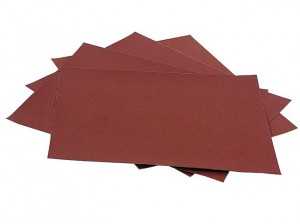
2. Since the surface of this type of pipe is very smooth, it must be pre-treated with fine sandpaper. Don't rub the pipe too hard. Just enough to make them a little rough. On a not very smooth surface of polypropylene pipes, the paint will last much longer.
3. After the entire surface of the polypropylene pipes has been treated with sandpaper, it must be coated with a primer or adhesion promoter for polypropylene. An adhesion promoter specifically designed for propylene is applied to the pipe surface either by spraying or by conventional wiping. After applying these substances, polypropylene pipes should dry well.
How paint is applied to pipes
After the pipes are completely ready for painting, you need to make sure that the temperature in the room is not less than 18 degrees Celsius. Required humidity - no more than 80%. It is best to apply paint on polypropylene pipes in one layer. The thickness of this layer should not be less than 60 microns and more than 120 microns. If you do not follow this rule, then the paint on the surface of polypropylene pipes will not last long and will not look very aesthetically pleasing.
Drying the painted surface
At a temperature of approximately 100 degrees Celsius, painted polypropylene pipes dry in just twenty minutes. The final polymerization of the paintwork occurs only after about seven days after applying the paint.The drying time of the paint prolongs the thicker applied layer, high humidity and low room temperature.
Paints for painting polypropylene pipes
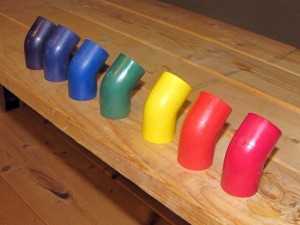
1. Spray paint KrylonFusion For Plastic. This paint for polypropylene pipes does not require pre-priming. It spreads as evenly as possible and dries very quickly.
2. Primer for plastics with poor adhesion Lankwitzer. The application of the primer does not require special surface preparation.
3. Water acrylic paints PaliPlast PL. Can be used for both indoor and outdoor use.
4. NEW TON enamels, produced in aerosol packaging. With their help, you can not only give the surface color, but also make it textured.
